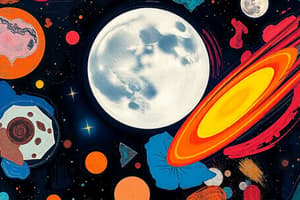Podcast
Questions and Answers
What is the primary reason humans' footprints on the Moon remain visible?
What is the primary reason humans' footprints on the Moon remain visible?
- The footprints were protected by a special coating.
- The Moon's gravity prevents changes to the surface.
- The surface of the Moon is made of ice.
- The Moon has no wind to erase them. (correct)
Which phase of the Moon occurs when it is completely illuminated from our perspective?
Which phase of the Moon occurs when it is completely illuminated from our perspective?
- Half Moon
- New Moon
- Full Moon (correct)
- Crescent Moon
How far is the Moon approximately from Earth?
How far is the Moon approximately from Earth?
- 1,000 kilometers
- 1,500,000 kilometers
- 384,400 kilometers (correct)
- 238,855 kilometers
What role does the Moon play in relation to Earth's oceans?
What role does the Moon play in relation to Earth's oceans?
Which of the following statements about the Moon is false?
Which of the following statements about the Moon is false?
Flashcards
Moon's distance from Earth
Moon's distance from Earth
The Moon is approximately 384,400 kilometers away from Earth.
Moon's size compared to Earth
Moon's size compared to Earth
The Moon is smaller than Earth, with a diameter of about 3,474 kilometers.
Moon's light source
Moon's light source
The Moon does not produce its own light; it reflects sunlight.
Moon phases
Moon phases
Signup and view all the flashcards
First Moon landing
First Moon landing
Signup and view all the flashcards
Study Notes
The Moon
- The Moon is Earth's only natural satellite, located approximately 384,400 kilometers away.
- It's significantly smaller than Earth, with a diameter of about 3,474 kilometers.
- The Moon doesn't produce its own light; it reflects sunlight.
- The Moon's phases (new, crescent, half, full) result from its orbit around Earth, exposing different portions illuminated by the Sun.
- The lunar surface is rocky and cratered, formed by meteor impacts long ago.
- There is no air or water on the Moon, making it uninhabitable for life as we know it.
- Humans first landed on the Moon in 1969 during the Apollo 11 mission, with Neil Armstrong and Buzz Aldrin being the first to walk on its surface.
- Footprints left by the astronauts remain on the Moon due to the lack of wind.
- The Moon's gravity influences Earth's tides.
- The Moon holds cultural significance in various societies and is portrayed in art and stories.
- Scientists continue to study the Moon, uncovering mysteries and inspiring people across the world.
Studying That Suits You
Use AI to generate personalized quizzes and flashcards to suit your learning preferences.
Related Documents
Description
Explore fascinating facts about the Moon, Earth's only natural satellite. Learn about its size, composition, phases, and cultural significance. Discover key moments in history, including the landmark Apollo 11 mission and its lasting impact on science and society.





